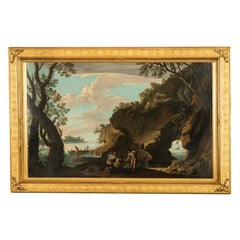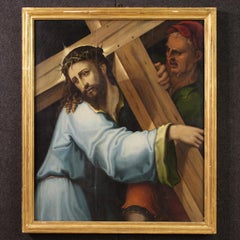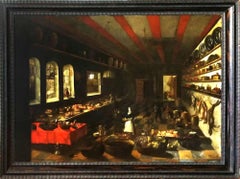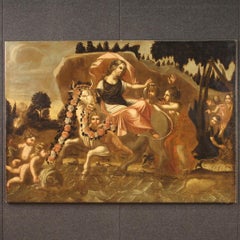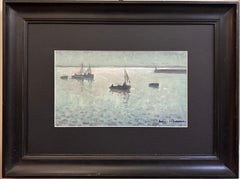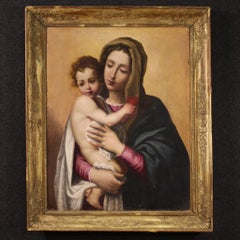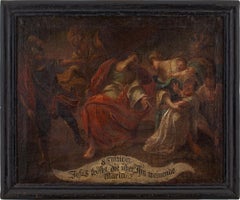1650s Figurative Paintings
to
2
1
2
2
4
Overall Width
to
Overall Height
to
961
2,411
13,268
30,512
284
286
565
781
575
765
921
981
1,028
1,010
463
3
1
7
2
7
4
3
2
1
1
1
1
1
1
1
9
8
3
3
1
1
1
6
1
6
3
Period: 1650s
Italian 17th Century Baroque Oil on Canvas Painting Coastal Landscape Fishermen
Located in Portland, OR
Italian 17th Century oil on canvas Baroque painting, attributed to Salvator Rosa (1615-1673), a coastal landscape scene with fishermen, circa 1650.
The painting depicts a rocky coast...
Category
Italian School 1650s Figurative Paintings
Materials
Oil, Canvas
17th Century Oil on Panel Italian Religious Painting Christ Carrying the Cross
Located in Vicoforte, IT
Splendid Italian painting from the first half of the 17th century. Oil on panel artwork of remarkable pictorial quality depicting Christ carrying the cross. The subject found particu...
Category
1650s Figurative Paintings
Materials
Wood, Oil
Interior Scene with Kitchen - Oil on Canvas - 1659
Located in Roma, IT
Signed and dated lower left.
Includes a beautiful later wooden frame cm. 137x8x182.
Very Good conditions.
Prov. Christie's London, February 15th 1974, n. 19.
This artwork is shippe...
Category
Baroque 1650s Figurative Paintings
Materials
Oil
Villagers in a Landscape - Flemish 17thC art figurative landscape oil painting
Located in London, GB
This fantastic Flemish 17th century Old Master oil painting is by Thomas Van Apshoven. It was painted circa 1650 and depicts a village with figures outside a tavern, eating, drinking and dancing. Beyond are more dwellings, villagers and animals, all under a blue summer's sky. The detail, brushwork and vibrant colouring are superb. This is an excellent example of Apshoven's work and a typical subject he loved to paint.
Provenance. Leominster estate.
Wax stamp verso.
Condition. Oil on panel, 22 inches by 17 inches and in good condition.
Frame. Housed In beautiful gilt frame, 30 inches by 25 inches and in good condition.
Thomas van Apshoven (1622– 1664) was a Flemish painter known for his landscapes with peasant scenes and genre scenes in interiors. His genre scenes depict village festivals, the interiors of taverns, village scenes or landscapes with peasants engaged in various activities, singeries, guardroom scenes and laboratories of alchemists. Some still lifes have also been attributed to him. His themes and style are close to that of David Teniers the Younger. He was born on 30 November 1622 in Antwerp as the eldest son of Ferdinand van Apshoven the Elder and Leonora Wijns. His father was a painter who had studied with Adam van Noort and had become a master of the Antwerp Guild of Saint Luke in 1596. No paintings by his father are known. His younger brother Ferdinand van Apshoven the Younger became also a successful painter. Thomas studied under his father. Some sources state that he became a pupil of the prominent genre painter David Teniers the Younger. It is more likely, however, that he was an imitator of Teniers. He was registered as a 'wijnmeester' [son of a master] in the Guild of St. Luke of Antwerp in the guild year 1645–1646. He married Barbara Janssens on 22 March 1645. The couple had four children. The godfathers of the children included the painters Victor Wolfvoet...
Category
Old Masters 1650s Figurative Paintings
Materials
Oil
17th century European oil, Christ and his disciples seated around a table.
Located in Woodbury, CT
17th century European oil, Christ and is disciples seated around a table.
An interesting and very unique painting.
Possibly a fragment originally from a piece of furniture.
The s...
Category
Old Masters 1650s Figurative Paintings
Materials
Oil, Wood Panel
$7,600 Sale Price
20% Off
17th Century Oil on Canvas Italian Antique Mythological Painting Rape Of Europa
Located in Vicoforte, IT
Antique Italian painting from the second half of the 17th century. Artwork oil on canvas depicting the mythological subject Rape of Europa of excellent pictorial quality. Painting of...
Category
1650s Figurative Paintings
Materials
Canvas, Oil
Italian Landscape with Jack Players, a painting by Gaspard Dughet (1615 - 1675)
By Gaspard Dughet
Located in PARIS, FR
Here Gaspard Dughet offers us an idyllic vision of the Roman countryside. The stages follow one another in a perfectly structured composition, revealing here a lake, there travellers walking along, gradually leading our eye to the blue horizon. But behind its classical composition, this landscape is particularly interesting because of three anthropomorphic details that the artist has hidden, opening the way to a radically different interpretation...
1. Gaspard Dughet, a landscape artist in the light of Poussin
Gaspard Dughet was born on June 4th, 1615 in Rome where his father, of French origin, was a pastry cook. He was probably named Gaspard in honour of his godfather Baron Gaspard de Morant, who was, or may have been, his father's employer. His older sister Jeanne married the painter Nicolas Poussin (1594 - 1655) on September 1st, 1630. The young Gaspard was apprenticed with his brother-in-law at the beginning of 1631, which led his entourage to name him Gaspard Poussin. The first preserved works of the painter date from the years 1633-1634 and were painted in Poussin’s studio.
Around 1635, Gaspard Dughet became emancipated and began to frequent the Bamboccianti circle. In 1636, he became friends with the painter Jean Miel (1599 - 1656), but also with Pier Francesco Mola (1612 - 1666) and Pietro da Cortona (1596 - 1669).
This was also the time of his first trips throughout Italy. The painter, although of French origin, appears never to have visited France. In 1646 he settled permanently in Rome. A recognized painter with a solid book of orders, he remained faithful to landscape painting throughout his life, alternating between cabinet paintings and large decorative commissions, using both oil and fresco.
Nailed to his bed by rheumatic fever at the age of 58, he died on May 25, 1675.
2. Discovering an idealized landscape
Beyond a relatively dark foreground that takes us into the landscape, we discover a vast bluish horizon: a plateau surrounded by deep ravines advances to the right, overhanging an expanse of water that sparkles below. A road winds through a mountainous mass as if leading us to the fortress that crowns it; another town appears in the distance at the foot of three conical mountains.
The composition is rigorous, mineral, and structured by geometric volumes. The various stages in the landscape lead one to the next attracting the eye towards the horizon located in the middle of the canvas. The general impression is that of a welcoming and serene nature.
In many places the paint layer has shrunk, or become transparent, revealing the dark red preparation with which the canvas was covered and accentuating the contrasts.
Human presence is limited to three jack players, leaning against a mound in the foreground. Their long garments, which may evoke Roman togas, contribute to the timelessness of the scene.
Close examination of the canvas reveals two other travellers on the path winding between the rocks. Made tiny by the distance, their introduction in the middle register, typical of Dughet's art, lengthens the perspective.
While it is difficult to date the work of a painter who devoted his entire life to the representation of landscapes, it is certain that this painting is a work from his later years. The trees that occupied the foreground of his youthful compositions have been relegated to the sides, a stretch of water separates us from the arid mountains counterbalanced by two trees represented on the opposite bank. The introduction of this stretch of water in the middle of the landscape betrays the influence of the Bolognese and in particular of the Dominiquin (1581 - 1641)
A number of similarities with a drawing in the British Museum might suggest a date around 1656-1657, since, according to Marie-Nicole Boisclair , it has been compared with the Prado's Landscape with the Repentant Magdalene, painted at that period.
3. Three amazing anthropomorphic details
While some late Renaissance landscapes offer a radical double reading, allowing one to see both a face or a human body behind the representation of a landscape, it seems interesting to us to hypothesize that Gaspard Dughet had fun here by slipping in a few details that, taken in isolation, evoke human or animal figures.
We will give three examples, looking closely at a cloud, the trunk of a broken tree and the top of a cliff.
The main cloud could thus evoke a Christ-like face or that of an antique god...
Category
Old Masters 1650s Figurative Paintings
Materials
Oil
Arabian nights The Thousand and One Nights Gustaf Tenggren attrib. Scheherazade
By Gustaf Tenggren
Located in Miami, FL
This is a masterfully rendered and brilliantly designed scene from the Arabian Nights. page 33 from Random House. We are not sure if this is by Gustaf Tenggren. ( Gustaf Tenggren At...
Category
Art Deco 1650s Figurative Paintings
Materials
Gouache
17th Century Oil on Canvas Italian Painting Genre Scene Bamboccioni, 1650
Located in Vicoforte, IT
Antique Italian painting from the 17th century. Oil painting on canvas depicting a lively popular genre scene of great charm, typical of the Bamboccianti school. Many Flemish and Ita...
Category
1650s Figurative Paintings
Materials
Canvas, Oil
Related Items
"Solitudine" paesaggio con barche a vela francia del nord cm. 37 x 21
Located in Torino, IT
Lanscape France,Ocean, France , grey, blue, azure, Normandy
Henry Maurice CAHOURS (Paris, 1889 – Vence, 1974)
He was born in Paris but spent his childhood and adolescence in Amiens...
Category
Post-Impressionist 1650s Figurative Paintings
Materials
Wood, Oil
$7,215
H 18.12 in W 23.63 in
Baroque Italian painter - Set of four 18th century figure paintings - Evangelist
Located in Varmo, IT
Italian painter (early 18th century) - Four Evangelists.
25.5 x 19 cm without frame, 29 x 22.5 cm with frame.
Ancient oil painting on panel. in wooden frames (not signed).
Conditi...
Category
Old Masters 1650s Figurative Paintings
Materials
Oil, Panel
$1,803 Sale Price
40% Off
H 22.84 in W 17.72 in
Very Large 1700's Dutch Old Master Oil Painting The Nativity Scene
Located in Cirencester, Gloucestershire
The Nativity
Dutch Old Master, early 1700's period
oil on canvas, unframed
canvas: 36 x 27.5 inches
provenance: private collection
condition: very good and sound condition, some scuf...
Category
Old Masters 1650s Figurative Paintings
Materials
Oil, Canvas
$2,844 Sale Price
30% Off
H 36 in W 27.5 in
Antique Italian painter - 18th century figure painting - Saint John Nepomuk
Located in Varmo, IT
Italian painter (18th century) - Saint John Nepomuk
65 x 50 cm without frame, 78 x 64 cm with frame.
Antique oil painting on canvas, in a gilded wooden frame (not signed).
Conditi...
Category
Old Masters 1650s Figurative Paintings
Materials
Canvas, Oil
$1,443 Sale Price
40% Off
H 30.71 in W 25.2 in
18th Century French Old Master Oil Painting Ancient Port Harbor Shipping Marine
Located in Cirencester, Gloucestershire
Harbor Scene
Circle of Claude Joseph Vernet (French, 1714-1789)
oil painting on canvas, framed in antique gilt frame
framed: 20.5 x 25.5
canvas: 19 x 23.5 inches
condition: very good...
Category
Old Masters 1650s Figurative Paintings
Materials
Oil, Canvas
$2,893 Sale Price
30% Off
H 20.5 in W 25.5 in
Antique English Grand Tour Old Master Oil Figures Classical Arcadian Landscape
Located in Cirencester, Gloucestershire
Classical Landscape
oil on canvas, framed
framed: 29 x 37 inches
canvas : 19 x 27 inches
Provenance: private collection, UK
Condition: the frame is exceptionally fragile and vulnerab...
Category
Old Masters 1650s Figurative Paintings
Materials
Oil, Canvas
$2,403 Sale Price
30% Off
H 29 in W 37 in
Circle Teniers, Flemish Art, Peasants smoking and drinking in a Tavern Interior
By David Teniers the Younger
Located in Greven, DE
Circle or Follower of David Teniers, Peasant in a Tavern Inn, drinking and smoking. Oil on canvas, Framed: 39 x 47 cm. Typical Flemish Baroque Interior...
Category
Baroque 1650s Figurative Paintings
Materials
Canvas, Oil
$2,645
H 13.78 in W 10.63 in
Vintage Oil Landscape Art of Redwood Forest California by 20th Century Artist
Located in Preston, GB
Vintage Oil Landscape Art of Redwood National Park Forest in California by 20th Century Artist, Tobias Everet Spence
Art measures 14 x 17 inches
Frame measures 21 x 24 inches
Th...
Category
Modern 1650s Figurative Paintings
Materials
Canvas, Oil, Wood, Paint, Wood Panel
$1,401 Sale Price
31% Off
H 24 in W 21 in D 2 in
Surrealist scene oil on canvas painting surrealism
Located in Barcelona, Barcelona
Oil on canvas.
Signed Aress.
Oil mesures 33x24 cm.
Frame mesures 48x39 cm.
Category
Surrealist 1650s Figurative Paintings
Materials
Canvas, Oil
The Poor Poet Antique German Oil Painting after the famous Carl Spitzweg work
Located in Cirencester, Gloucestershire
The Poor Poet
German School, early 20th century
after the original painting by Carl Spitzweg (c.1839)
inscribed verso
oil on board, framed
framed: 15.5 x 17.5 inches
board: 12 x 15 i...
Category
Mannerist 1650s Figurative Paintings
Materials
Oil
$877 Sale Price
30% Off
H 15.5 in W 17.5 in
Large 18th Century British Old Master Oil Painting Figures at Dusk in Woodland
Located in Cirencester, Gloucestershire
The Close of Day
English artist, second half 18th century
circle of Thomas Gainsborough (British 1727-1788)
oil on canvas, unframed
canvas: 24.5 x 29 inches
provenance: private colle...
Category
Old Masters 1650s Figurative Paintings
Materials
Oil, Canvas
$2,158 Sale Price
30% Off
H 24.5 in W 29 in
Fine 1800's French Oil Figures by Monastic Ruins Stream Bucolic Landscape
Located in Cirencester, Gloucestershire
Monastic Ruins by a Stream
French School, early 1800's
oil on canvas, framed
Framed 15 x 19 inches
Canvas : 12.5 x 16 inches
Provenance: private collection, France
Condition: very go...
Category
Old Masters 1650s Figurative Paintings
Materials
Oil
$1,466 Sale Price
30% Off
H 15 in W 19 in
Previously Available Items
17th Century Oil on Canvas Italian Religious Painting Madonna with Child, 1650
Located in Vicoforte, IT
Refined 17th century Italian painting. Oil on canvas artwork depicting a splendid Madonna and Child, of remarkable pictorial quality, inspired by the Tuscan school of Andrea del Sart...
Category
1650s Figurative Paintings
Materials
Canvas, Oil
H 38.19 in W 31.5 in D 3.15 in
Mid-17th-Century German School, Jesus Meets The Women Of Jerusalem
Located in Cheltenham, GB
This compelling mid-17th-century German oil painting depicts Christ meeting the women of Jerusalem on the way to Calvary.
Formerly hanging within an ecclesiastical setting, this enchanting survivor is one of 14 ‘Stations of the Cross...
Category
1650s Figurative Paintings
Materials
Canvas, Oil
Man Portrait by Pearl Shönfeld Oil on Canvas
Located in Pasadena, CA
Oil painting on canvas representing a bautifull portrait of man . Treated as a rough the painting seems not finished which makes the painting interesting . The mystery of this unfini...
Category
American Modern 1650s Figurative Paintings
Materials
Oil
Joseph greeting his Brothers, a preparatory study by Pier Francesco Mola
By Pier Francesco Mola
Located in PARIS, FR
The attribution of this drawing to Pier Francesco Mola has been confirmed by Dr. Francesco Petrucci, an expert of the artist.
This extraordinary study was executed around 1656 by Pier Francesco Mola, one of the masters of the Roman Baroque. With great technical virtuosity, Mola combines a preparatory drawing executed in red chalk and pen with washes of grey and brown inks and highlights of white lead. Although very different from the final outcome, it is probably an early thought for the fresco the artist painted in the gallery commissioned by Pope Alexander VII for the Quirinale Palace, a fresco which, according to the British art historian Ann Sutherland Harris, was "his largest single composition and probably the most prestigious commission of his career”.
1. Pier Francesco Mola, a painter of Baroque Rome
Pier Francesco Mola was born in Coldrerio, Ticino, near Lugano, on 9 February 1612. His father Giovanni Battista was a well-known architect and the family moved to Rome in 1616, where Pier Francesco spent most of his career.
Trained in the workshops of the Cavaliere d'Arpino (1568 - 1640) and Domenico Zampieri, known as Dominichino (1581 - 1641), Mola made two jouneys to northern Italy, one from 1633 to 1640, and the second from 1641 to 1647, which led him to stay in Bologna and Venice, before returning to settle permanently in Rome. He was also influenced by the classicism of Francesco Albani (1578 - 1660), whose workshop he frequented.
While Joseph greeting his brothers is his main fresco, Pier Francesco Mola was also an important painter of easel paintings. A leading figure in the neo-Venetian movement in Rome, alongside Pietro Testa (1617 - 1650) and Andrea Sacchi (1599 - 1661), he sought to reconcile Bolognese aesthetics with Venetian colour. He sometimes collaborated with Gaspard Dughet, and at the end of his life (1660-1666) he also revealed himself as a great landscape painter. He was linked to the Franco-Roman classical milieu (Poussin, Lorrain and Dughet), giving his figures a realism close to Ribera’s.
His graphic work has always been sought after, particularly across the Channel, as the early provenance of the sheet we are presenting demonstrates. It comes from one of the most prestigious collections formed in England in the second half of the 18th century, that of the painter Sir Joshua Reynolds (1723 - 1792), who was the first president of the Royal Academy from 1768 onwards.
2. Description of the artwork
Pier Francesco Mola displays here all the facets of his talent, and in particular his very specific way of incorporating figures into a lush landscape. Our study focuses on the figures of Joseph and Benjamin, recounting the moment when the latter " fell upon his brother Benjamin's neck and wept" (Genesis 45-14).
This episode terminates the story of Joseph, who had been sold by his brothers to merchants who took him to Egypt, where he became Pharaoh's trusted man, interpreting his dreams. Thanks to him, Pharaoh built up stocks of food during the seven years of plenty, which enabled him to feed his people during the seven years of famine. Joseph's hungry brothers came to buy grain from him and returned a second time with Joseph's younger brother Benjamin at Joseph’s request. This is the moment that Joseph chooses to reveal his true identity to his brothers, showing special tenderness for Benjamin, his own mother's only other son.
While Joseph rushes towards Benjamin with ardour, Benjamin seems more reserved as he advances towards Joseph, suggesting perhaps that it is the forgiver who must make the first move. "Benjamin wept upon his neck," adds the Genesis, and this weeping is evoked by his left arm being folded as if to hide his tears.
The figures of Joseph and Benjamin were probably the main concern of the painter in this study. Their half-brothers are depicted in the background, massed to the left of the study. Their static silhouettes, sketched in a rather schematic manner, contrast with the dynamism of the encounter between Joseph and Benjamin, whose clothes flutter as if animated by a light wind.
The complex technique of this study places it at the borderline between drawing and painting, thanks in particular to the white lead highlights that give life to the two main figures, and to the very fluid ink washes, as for example in the representation of the grove of trees on the right.
Much of the charm of this drawing lies in the evocative description of the landscape - probably the banks of the Nile - in which the artist introduces an impression of depth by evoking the reflection of the trees in the water in the background of the composition.
3. A long maturation for the subject
The gallery of the Palazzo del Quirinale is one of the great commissions of the pontificate of Alexander VII. It was entrusted to Pietro da Cortona in 1655, who was responsible for bringing together a group of artists to carry out this decorative programme. At the end of the gallery two scenes were executed by the two main painters who participated in this vast decorative programme: the Adoration of the Magi by Carlo Maratta and Joseph greeting his Brothers by Pier Francesco Mola. This arrangement takes up the idea of associating an Old Testament scene with a New Testament scene, and we can see in the story of Joseph who makes himself known to his brothers at the height of his power a counterpoint to the humility of the birth of Christ, recognised by the shepherds.
Numerous preparatory drawings for this fresco have survived, reflecting the importance of this papal commission for Pier Francesco Mola. In his book published in 1972, Richard Cocke lists 12 known preparatory studies. Our drawing, which was kept in private collections at the time, has not yet been studied by art historians, but we shall see, by focusing on the evolution of the figure of Joseph, that it is most probably be a very early thought, executed before the one kept in the British Museum, which was considered by this art historian to be the oldest drawing in the series.
In this composition (9th photo of the gallery), made on an inverted basis, we find the three figures formed by Joseph, who is represented in a manner very similar to that of our drawing, Benjamin, who has become a young adolescent, and one of the brothers whose arm balances, as in our drawing, that of Joseph.
This brother is now depicted standing instead of sitting, giving the composition more dynamism. The group of the other brothers unfolds like an antique frieze in a mineral landscape in which vegetal references have disappeared. As in the drawing in the Musée Atget in Montpellier and as in our study, Mola presents Joseph running to greet Benjamin in an intimate and personal gesture that does not include his other brothers.
The next stage in the evolution of the composition is presented to us in a study in the Museum Kunstpalast in Düsseldorf (10th photo of the gallery) in which Mola depicts Joseph with his arms open, including all his brothers in his greeting.
Whereas in the first sketches Joseph was depicted as a bearded middle-aged man - which was consistent with the fact that he is around forty years old according to the Bible at the time of this meeting - Mola later rejuvenates him, as he looks closer in age to Benjamin.
The following preparatory studies are entirely devoted to the complex arrangement of the group of brothers. In the final composition (last photo of the gallery), this group is now split into two parts: six of them are shown kneeling in a deferential position. Benjamin is shown standing with his arms folded in the background, in front of four other brothers who are also standing. It is also interesting to note that this final composition reintroduces the vegetal background, as we are now in a courtyard bordered by a balustrade beyond which lush gardens extend. Their trees look quite similar to those represented in the right of our study.
4. A prestigious provenance: Sir Josuah Reynolds
Sir Joshua Reynolds (Plympton 1723 - London 1792) can be considered as the leader of the English school of painting in the 18th century. Specialising in portraiture, he was the co-founder and first president of the Royal Academy. His youth was marked by a long journey to Italy between 1749 and 1752 and his favourite masters remained throughout his life Michelangelo, Raphael, the other Italians of the 16th century and Claude Gellée.
He was the most discerning collector among the painters of his time. His eclecticism, constantly in search of the "great style", is evident both in his lectures at the Royal Academy and in the choice of his collections, to which he devoted a large part of his income. We don’t know whether he started buying some drawings in Italy or whether those were only purchased after his return to England.
In his 8th lecture, Reynolds describes the charm that drawings held for him in terms that apply quite well to the drawing we are presenting: “From a slight, undetermined drawing, where the ideas of the composition and character are, as I may say, only just touched upon, the imagination supplies more than the painter himself, probably, could produce; and we accordingly often find that the finished work disappoints the expectation that was raised from the sketch. “
The bulk of his drawings were sold at auction on 26 May 1794 and again from 5 March 1798. The mark in the lower right corner of our drawing was inscribed by his executors on Reynolds' death. They marked the 1163 best drawings (of which our sheet was part) on the recto, while the inferior drawings were stamped on the verso.
This drawing has since been kept in the UK. His last known owner was the writer Anthony Powell...
Category
Old Masters 1650s Figurative Paintings
Materials
Chalk, Ink, Pen
1955 Vintage Framed Abstract Figurative Gouache Painting - The Matador
Located in Bristol, GB
THE MATADOR
Size: 73 x 53 cm (including frame)
Gouache and watercolour on Paper
A striking mid century gouache and watercolour figure composition, painted in 1955.
A semi abstract ...
Category
Abstract 1650s Figurative Paintings
Materials
Paper, Watercolor, Gouache
Virgin - Original Oil Painting - 1650s
Located in Roma, IT
Virgin is an original Old Master Painting realized in the first half of the XVII Century by an artist of the Roman School.
Original Oil Painting on Canvas.
Total dimensions: 100 ...
Category
Old Masters 1650s Figurative Paintings
Materials
Canvas, Oil
Dutch or English Old Master portrait of a noble lady, pearl earrings, necklace
Located in Woodbury, CT
17th century Dutch or English Old Master portrait of a noble lady, wearing pearl earrings and a necklace
Outstanding old Master portrait either of a Dutch or English lady very much in the style and manner of Sir Anthony Van Dyke...
Category
Old Masters 1650s Figurative Paintings
Materials
Oil
Bowlers - Original Oil on Canvas by the School of D. Teniers Le Jeune - 1659
Located in Roma, IT
Village with Bowlers is an original modern artwork realized in 1659 by the School of David Teniers.
Original oil on canvas.
Signed "D. Teniers 1659" on the lower right corner.
Authenthicy inscription by Prof. Biancale on the back.
The canvas has been restorated in the XX Century; restoration points diffused on the sky, on the blocks of flats, on the figures and on the signature.
Very fine and quality work representing a genre scene: several people are playing with bocce in a village. The scene is characterized by an horizontal side and the landscape is natural and warm. The work has been realized by one of the pupil of David Teniers in the middle of the XVII Century.
David Teniers, known as the Younger (Antwerp, 15 December 1610 - Brussels, 25 April 1690), was a Flemish painter. Son of the painter David the Elder, and best known brother of three other painters, he began his activity in Antwerp. He was one of the pupils of his father, through which he learned the style of Adam Elsheimer...
Category
1650s Figurative Paintings
Materials
Oil
H 24.81 in W 49.41 in
Read More
See Kent Monkman’s Magical Realist Take on Frontier History
With a solo show at the Denver Art Museum and a commission from the Met, the Cree Canadian painter has become an international sensation.
Cecilia Vicuña Merges Politics, Science and Spirituality in Her Poetic Art
The Chilean creator, who has been living in exile in New York for decades, is having a major moment, receiving the biggest exhibitions, commissions and awards an artist could dream of.
